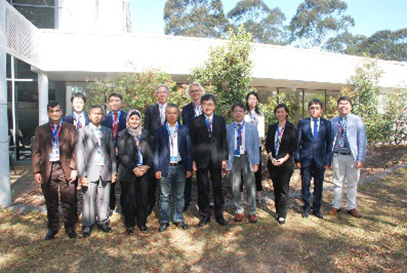MENU

|
Research on Climate Change using Nuclear and Isotopic Techniques
|
|
- 1. Aim and Background
The overall aim of the project is to better understand the mechanisms and processes of past climate variability through undertaking nuclear and isotopic based experiments and analyses that support research into past climate change, and sharing the expertise to interpret the new knowledge.
This multi-disciplinary research combines radionuclide, stable isotope analysis and conventional analytical techniques with ecological methods to obtain datasets that allow reconstructions of high resolution climate records, from a variety of different proxies or indicators that have been archived in the environment.
Using radionuclides and isotopes we are able to identify and date past climate change with the goal of interpreting the drivers of the Earth’s climate system. In order to achieve this, we aim to reconstruct high-resolution climate information using tree-ring, corals and lake archives from key regions in the Asia-Pacific region. We will use the reconstructions to understand climate drivers and processes, such as the Australasian Monsoon, El Niño Southern Oscillation (ENSO), Indian Ocean Dipole and Inter-decadal Pacific Oscillation.
- 2. Archives and associated indicators of climate change
Four examples of environmental archives, the analytical techniques used ,and the climate information that can be obtained from them, are listed below. In all cases, in addition to a diverse range of analyses, appropriate expertise in fieldwork and core/ sample collection is required.
- 2.1. Lake sediments
There are a range of climate indicators that can be extracted and analysed from lake sediments. Proxies such as pollen, charcoal, diatoms, stable isotopes and geochemistry (elemental and grain size analysis) can indicate changes in vegetation, water quality and sedimentation. Combining these proxies can help build a picture of past climates regionally and, when combined, globally. The chronology of these changes can be developed using Pb-210, Cs-137 or Pu isotope analysis for the upper section of the core, and using C-14 analysis of macrofossils, bulk organic material or shells through the length of the core.
- 2.2. Tree-rings
As a tree grows, annual climate signals are embedded within the composition and structure of the wood. Climatic changes (eg, temperature and precipitation) can be reconstructed from oxygen stable isotope signals combined with the cellulose and ring-width information. In tropical and mid-tropical areas where seasonal changes are small, it is difficult to visually identify individual growth rings. Seasonal changes can be identified using changes in elemental composition analysed using the Itrax X-ray Fluoresence (XRF) core scanner and verified using AMS C-14 dating.
- 2.3. Coral
The skeletons of corals provide a record of the chemical and physical conditions that existed in the surrounding seawater at the time of its growth. High growth rates mean that the corals can provide a high resolution record of information on past ocean circulation changes, sea surface temperatures and ocean chemistry, which can indicate changes in processes like ENSO and the Indian Ocean Dipole. Techniques such as U/Th dating, C-14 dating, stable isotope analysis (particularly δ18O), minor and trace element composition (eg Sr/Ca ratios) using ICP/MS, and SEM/XRD to analyse for diagenesis, are combined to reconstruct past climates. Collection of coral samples requires highly experienced divers, and appropriately equipped ships.
- 2.4. Landscape change and river basins
The measurement of in-situ produced cosmogenic nuclides, Be-10, C-14, Al-26, and Cl-36 in quartz rich and calcareous lithologies from intact exposed bedrock surfaces within river transported bedload, and from alluvial and colluvial valley sediments, in landslide debris, in straths and coastal delta fans, are powerful tools to understand the timing of stochastic events and rates of processes. Such processes change our landscape (such as bedrock erosion, river incision, basin-wide sediment generation, storage and transport, landslides frequency, coastal escarpment degradation) leading to a better understanding of human impact and climate change.
- 3. Carbon storage
Carbon storage is an important component of modern climate studies. A better estimate and understanding of carbon storage in a range of different soils, as well as coastal wetlands and seagrass beds, will lead to improved climate modelling related to CO2 emissions and budgets. This FNCA project will address this by applying nuclear-related techniques to study temporal as well as spatial aspects of carbon storage. Nuclear and isotopic techniques used include Pb-210, Cs-137 dating using radiochemistry; C-14, Be-10, Al-26 and Pu isotope dating using accelerator mass spectrometry; stable isotope analysis δ13C, δ14N, δ18O using isotope ratio mass spectrometry; and U/Th dating using MC-ICPMS or TIMS. Complementary analytical and other methods include the high resolution Itrax X-ray Fluoresence (XRF) core scanner, pollen analysis, diatom analysis and sediment grain size analysis.
|
|
|